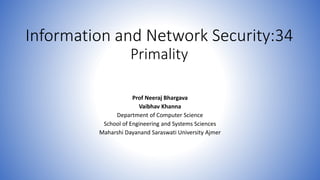
Information and network security 34 primality
- 1. Information and Network Security:34 Primality Prof Neeraj Bhargava Vaibhav Khanna Department of Computer Science School of Engineering and Systems Sciences Maharshi Dayanand Saraswati University Ajmer
- 2. Prime Numbers prime numbers only have divisors of 1 and self they cannot be written as a product of other numbers note: 1 is prime, but is generally not of interest eg. 2,3,5,7 are prime, 4,6,8,9,10 are not prime numbers are central to number theory list of prime number less than 200 is: 2 3 5 7 11 13 17 19 23 29 31 37 41 43 47 53 59 61 67 71 73 79 83 89 97 101 103 107 109 113 127 131 137 139 149 151 157 163 167 173 179 181 191 193 197 199
- 3. Prime Factorisation to factor a number n is to write it as a product of other numbers: n=a x b x c note that factoring a number is relatively hard compared to multiplying the factors together to generate the number the prime factorisation of a number n is when its written as a product of primes eg. 91=7x13 ; 3600=24x32x52
- 4. • The idea of "factoring" a number is important - finding numbers which divide into it. • Taking this as far as can go, by factorising all the factors, we can eventually write the number as a product of (powers of) primes - its prime factorisation. • Note also that factoring a number is relatively hard compared to multiplying the factors together to generate the number.
- 5. Relatively Prime Numbers & GCD • two numbers a, b are relatively prime if have no common divisors apart from 1 • eg. 8 & 15 are relatively prime since factors of 8 are 1,2,4,8 and of 15 are 1,3,5,15 and 1 is the only common factor • Have the concept of “relatively prime” if two number share no common factors other than 1. • Another common problem is to determine the "greatest common divisor” GCD(a,b) which is the largest number that divides into both a & b. • conversely can determine the greatest common divisor by comparing their prime factorizations and using least powers • eg. 300=21x31x52 18=21x32 hence GCD(18,300)=21x31x50=6
- 6. Fermat's Theorem • ap-1 = 1 (mod p) • where p is prime and gcd(a,p)=1 • also known as Fermat’s Little Theorem • also have: ap = a (mod p) • useful in public key and primality testing • Two theorems that play important roles in public-key cryptography are Fermat’s theorem and Euler’s theorem. • Fermat’s theorem (also known as Fermat’s Little Theorem) as listed above, states an important property of prime numbers.
- 7. Euler Totient Function ø(n) • when doing arithmetic modulo n • complete set of residues is: 0..n-1 • reduced set of residues is those numbers (residues) which are relatively prime to n • eg for n=10, • complete set of residues is {0,1,2,3,4,5,6,7,8,9} • reduced set of residues is {1,3,7,9} • number of elements in reduced set of residues is called the Euler Totient Function ø(n)
- 8. Euler Totient Function ø(n) • to compute ø(n) need to count number of residues to be excluded • in general need prime factorization, but • for p (p prime) ø(p)=p-1 • for p.q (p,q prime) ø(p.q)=(p-1)x(q-1) • compute ø(n) need to count the number of residues to be excluded. In general you need use a complex formula on the prime factorization of n, but have a couple of special cases as shown. • eg. ø(37) = 36 ø(21) = (3–1)x(7–1) = 2x6 = 12
- 9. Euler's Theorem • a generalisation of Fermat's Theorem • aø(n) = 1 (mod n) • for any a,n where gcd(a,n)=1 • Euler's Theorem is a generalization of Fermat's Theorem for any number n. • As is the case for Fermat's theorem, an alternative form of the theorem is also useful. Again, similar to the case with Fermat's theorem, the first form of Euler's theorem requires that a be relatively prime to n. • eg. a=3;n=10; ø(10)=4; hence 34 = 81 = 1 mod 10 a=2;n=11; ø(11)=10; hence 210 = 1024 = 1 mod 11 • also have: aø(n)+1 = a (mod n)
- 10. Primality Testing often need to find large prime numbers traditionally sieve using trial division ie. divide by all numbers (primes) in turn less than the square root of the number only works for small numbers alternatively can use statistical primality tests based on properties of primes for which all primes numbers satisfy property but some composite numbers, called pseudo-primes, also satisfy the property can use a slower deterministic primality test
- 11. • For many cryptographic functions it is necessary to select one or more very large prime numbers at random. Thus we are faced with the task of determining whether a given large number is prime. • There is no simple yet efficient means of accomplishing this task. • Traditionally sieve for primes using trial division of all possible prime factors of some number, but this only works for small numbers. • Alternatively can use repeated statistical primality tests based on properties of primes, and then for certainty, use a slower deterministic primality test, such as the AKS test.
- 12. Assignment • Explain in detail the working of Primality Algorithm